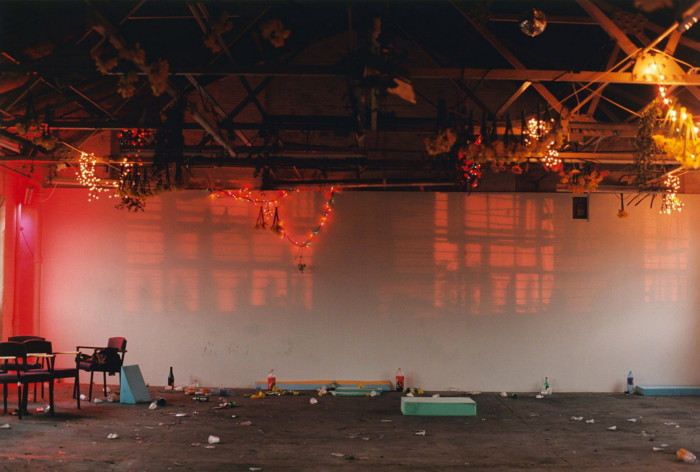
Wolfgang Tillmans seems to think we’ve all lived the life he photographed. “I can get in touch with somebody when they recognise a feeling,” he has said, claiming to read his public’s thoughts: “‘Oh, I felt like that before. I remember jeans hanging on a banister, even though I’ve never seen that exact pair. I’ve seen my oranges on a windowsill.’ It’s the sense that ‘I am not alone’.”
Wolfgang Tillmans: To look without fear, a full-immersion retrospective at MoMA in New York, overflows with such moments of presumed recognition. There are, in fact, oranges on a windowsill and a pair of jeans dangling from a banister. Also, living rooms defaced by the detritus of a night’s partying, and an abundance of hairy armpits, hairy balls and stubbled heads. People dance, kiss, clean themselves in baths and showers. Tillmans’ work depends on the sense of community that these fragments of existence might foster, instants preserved and ennobled by the fact that he observed them. Surely you, dear viewer, who have known sweat and boots and hangovers, are moved by the knowledge that others have, too.
Or possibly not. Tillmans’ photographs emerged from a context that is more transient and clubby than universal. Technically haphazard or out-of-focus, they speak most stirringly to those who were young in the 1990s — specifically, to the subculture of ecstatic dance parties, exuberant sexual experimentation, cassette mix tapes, filthy apartments and stained sheets. I do belong to Tillmans’ generation, but not to his world, and the feeling I get from his early photographs is less “you’ve been here” than “you had to be there”.


MoMA’s blowout puts the full force of the museum’s institutional cred behind the 54-year-old artist’s output. Eight years in the making, with 417 works that fill the entire sixth floor, the show aims to be definitive. It also seems valedictory because while Tillmans could still have decades of creative work ahead of him, as a photographer he seems spent. “To look without fear” centres on the era between the fall of the Berlin Wall and Brexit, when Europe was a land of open borders and freewheeling cosmopolitanism. It oozes with nostalgia for a time before ubiquitous digital cameras and social media, when professionals could titillate connoisseurs by celebrating amateurishness, and the idea of documenting nothing much could still be read as transgressive.
His most memorable photos came early in his career. A 1992 shot captures his friends Lutz and Alex perched in a tree, wearing only chic raincoats that fall open to reveal their prelapsarian nakedness. Like impishly androgynous versions of Adam and Eve, they have climbed the forbidden tree and sit entwined in foliage, their dewiness fixed forever. The edgy indie publication i-D included this shot in a spread of Lutz and Alex’s cryptic relationship (the title was “like brother like sister: a fashion story”), propelling Tillmans into the world of magazines, photojournalism, art galleries and museums.

From the beginning, he grasped the power of art historical reference to elevate the everyday. Portraits of his friends evoke the scrawny, elongated bodies of German Renaissance nudes. In a 1988 self-portrait in a swimsuit, Tillmans adopts the contrapposto of Cézanne’s monumental male bather (a star in MoMA’s collection). “Anders pulling a splinter from his foot” (2004) summons the torqued body and fixed concentration of the “Spinario”, a Roman bronze in the collection of the Metropolitan Museum.
MoMA acknowledges these links to the past, but it’s far more intent on pumping up both Tillmans’ radicalism and his continued relevance. In a catalogue essay titled “The Wandering Image”, senior curator Roxana Marcoci makes much of the fact that his work has appeared in many formats: postcards, posters, music videos, set designs and so on. “By transmitting, sharing and setting images free, by multiplying their lives, he proposes a fully democratised experience of art,” she writes.

Never mind that he was hardly the first photographer to publish wherever and however he could, or to slip from the rarefied to the plebeian and back again. More important, Marcoci’s claim, like the show as a whole, ignores the way the smartphone and social media have done a more thorough job of decentralising, distributing and democratising images than any single maestro ever could.
Now everyone can do what Tillmans did in the 1990s: cherish the magic of banality. Sure, he was uncannily prescient about today’s deluge of pets, plants, selfies, sunsets and dick-pics. He saw such undistinguished snapshots as agents of empathy, all-in-one oracles of feelings, thoughts and ideas. But what happens to your uniqueness when your insight becomes obvious? MoMA sets out to make an argument for a body of work that winds up foundering on its own mediocrity. Asserting that he got there first isn’t enough.


Tillmans dismisses the whole idea of a photograph as aesthetic object, yet he also gets prickly when critics dismiss his work as shallow. “A painting by Ernst Ludwig Kirchner or George Grosz of a nightclub scene from 1924 Berlin [is] seen as culture in a museum,” he has said. “Whereas people would shrug off a wild night at the Front nightclub as a decadent party.” He appears to confuse subject matter with form. Grosz made nightlife meaningful because he brought his gifts as painter and draftsman to bear on political satire. Tillmans has no such power.
What makes this retrospective so disappointing is not just the work’s unimpressive artistry, but also its stunted consistency. Tillmans hasn’t developed much since his heyday, a fact that he tries to hide with a non-chronological arrangement. Though he continues to worship youth, his improvisational manner has aged poorly. He took up digital photography in 2008, but its precision gleam undercuts the homemade roughness, so that his post-conversion pictures become suddenly more impersonal and generic. Spare abstractions that suggest tight close-ups of crumpled fabric, terrazzo floors or drying paint are precisely as interesting as they sound. He tries to compensate for the scant charm of these sterile works by sprinkling them among shots of unwashed, unapologetic youths, and also by making them really big.


The installation is part of the opus. Tillmans prints his pictures in dimensions that range from postcard to mural, and hangs them in seemingly random groupings, including at toddler height or near the ceiling. Some are fixed to the wall with scotch tape or push pins, while others are meticulously framed. Navigating this exhibition feels like a game with secret rules and no obvious goal.
This dorm-room style comes off as affectation, a way to distract from repetitiveness. The approach is more reactionary than radical. The point that photography lies somewhere between mass-market medium and a museum-worthy object has been made many times before, and the studied informality of the way it’s hung hearkens back to El Lissitzky’s 1929 Film und Foto showcase of avant-garde photographs and MoMA’s own Family of Man blockbuster in 1955.
In the end, the current show manages to undercut its own premise: instead of presenting Tillmans as a pivotal, crucial figure, it reveals a tentative, backward-looking artist left behind by his own revolution.
To January 1, moma.org
Stay connected with us on social media platform for instant update click here to join our Twitter, & Facebook
We are now on Telegram. Click here to join our channel (@TechiUpdate) and stay updated with the latest Technology headlines.
For all the latest Art-Culture News Click Here
